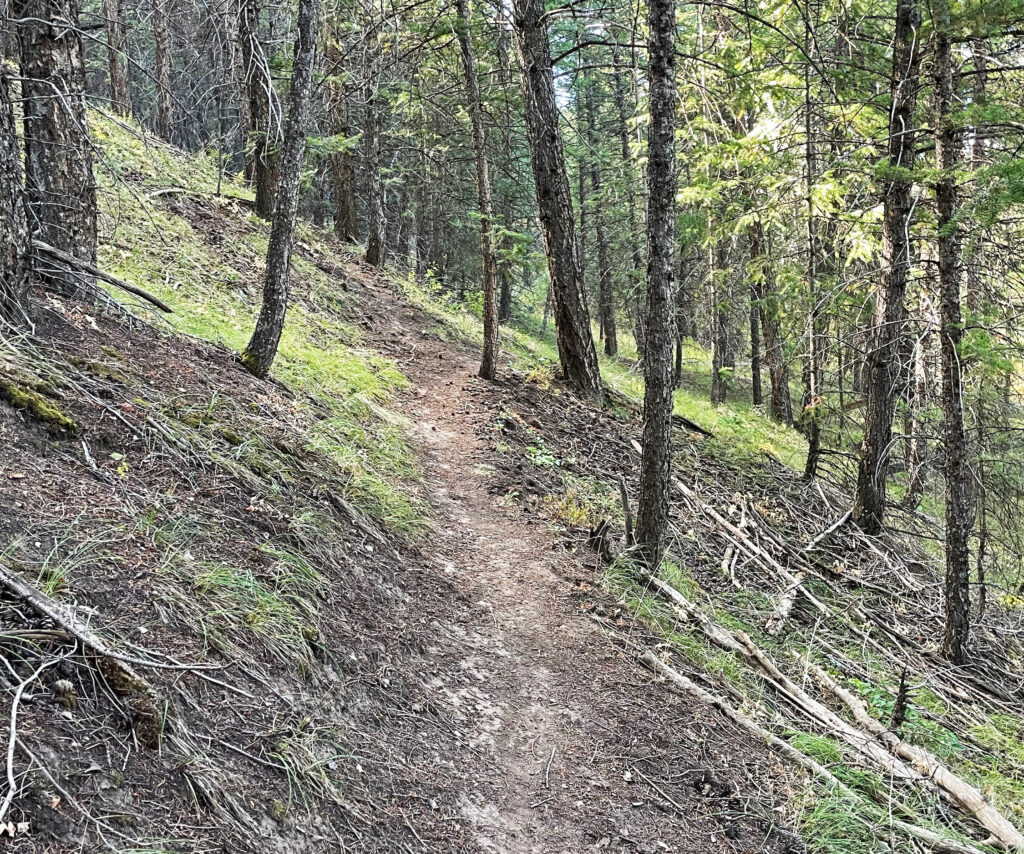A proposed extension to the EagleVail Trail that would complete a dirt trail linkage between Avon and Minturn is currently under U.S. Forest Service review. Despite approval from Avon and EagleVail leadership, some nearby homeowners still hope the trail extension does not come to fruition.
The 1.64-mile proposed extension would connect from the EagleVail Trail’s existing western terminus above Grouse Court in EagleVail westward, terminating at the Beaver Creek roundabout in Avon.
The extension has been approved by the EagleVail Metropolitan District Board, the Avon Town Council, and the owners of three private properties it would pass through.
The remaining stakeholder, the Forest Service, is still reviewing the 0.27-mile section of the trail that passes through White River National Forest land. The Forest Service must conduct a National Environmental Policy Act (NEPA) review, an environmental analysis to consider the potential impacts of the project.
Leanne Veldhuis, Eagle-Holy Cross district ranger for the Forest Service, said she expects to have completed internal review and be nearing a decision in August.
History of the extension
A western extension to the EagleVail Trail, which currently ends at Grouse Court, has been on the table since the trail was created in 2010.
The extension was tabled, however, until last year, when Breckenridge Grand Vacations, the owners of the Frontgate Avon property, offered the Vail Valley Mountain Trails Alliance an easement on their land for the trail. The easement was also publicly reviewed and approved by the Avon Town Council.
In November, Vail Valley Mountain Trails Alliance Executive Director Ernest Saeger presented on the trail extension proposal to the EagleVail Metropolitan District Board. Saeger returned to the board in March, and again in July. By the July meeting, the board had approved the project and agreed to become its sponsor to the Forest Service.
Why extend the EagleVail Trail?
The extension would take the place of a “well-established, pretty well-used” spiderwebbing network of social trails in western EagleVail, Saeger said. Social trails — which are illegal — have numerous problems, from impacting flora and fauna to causing erosion and soil damage.
Additionally, a lot of the social trails above western EagleVail start and end in backyards, connecting to 25 total private properties and occasionally drawing confused visitors toward residents’ homes.
The Vail Valley Mountain Trails Alliance studied the social trails, aiming to determine the trails’ relevance, impact and use value. “We came to the determination that this is a social trail that’s close to a neighborhood, that does provide a benefit, that sees a good amount of use,” Saeger said.
Tim McGuire, chair of the EagleVail Metropolitan District Board, said the trail extension will also improve the safety of users. At the moment, those coming from the west that wish to reach the EagleVail Trail must ride along the bike path on U.S. Highway 6, and then on the roads in EagleVail.
“There have been many accidents along Route 6, and to allow recreationists to stay away from the highway completely on a soft trail, I think, is just a great addition and improves the safety within our community,” McGuire said.
Then there is the connectivity piece. Having a dirt trail that users can travel on from Avon to Minturn has a lot of appeal, McGuire and Saeger both said. (Users can currently travel from EagleVail to Minturn on the Everkrisp Trail.) This is also reflected in several public comments collected by the Forest Service.
Plus, Saeger said, the trail is for the community. “It will be highly used by hikers and dog walkers and trail runners more than anyone. And it’ll be a very nice, relaxing, connecting trail that I believe will be used by our community more than anything,” Saeger said.
As EagleVail, Avon, Forest Service collect public comment, some still dissent
Madeleine Berenson — a western EagleVail homeowner who has become an unofficial spokesperson for the dissenting group — first learned about the proposed trail extension in a text from a neighbor. “The more I found out about it, the more concerned I became,” Berenson said.
While both the EagleVail Metropolitan District Board and the Avon Town Council are required to publicly notice discussion topics ahead of scheduled meetings, and to receive public comment, neither organization is required to actively solicit input from residents.
“It felt especially violating to know that there was an entity that had made this decision without consulting us, without including us, without checking in with us to see if it’s something we even wanted,” Berenson said of the EagleVail Metropolitan District Board.
The NEPA review process requires the Forest Service’s wildlife biologists, botanists and archaeologists to assess and report on the site. It also requires that the Forest Service collect public comment.
The Forest Service held an open public comment period on the EagleVail Trail extension in the spring, including sending out a public scoping letter.
The Forest Service collected comments from 176 people. The vast majority were in favor of the trail.
Although the official public comment period ended in April, the Forest Service will still receive comments on the national forest section of trail until a decision has been made.
In whose name is the EagleVail Trail extension being completed?
Perhaps the biggest frustration for the homeowners that do not want to see the trail extension completed is that they do not feel they have been heard by the EagleVail Metropolitan District Board.
“The Metro District is really committed to their decision to expand the EagleVail Trail, and they don’t seem to believe or accept the point of view of the people who don’t think it’s a good idea, and they have not given satisfactory responses to the concerns that we do have,” Berenson said.
“My feeling is that the metro district is concerned with generating revenue that supports the entities that they oversee,” Berenson said. “And I feel as though the expansion of the EagleVail Trail, to them, means another entity that they can promote in their marketing materials and on the website that they think will be attractive to people who are visiting here.”
When asked about this claim, McGuire said, “We want to take into consideration everyone’s opinion when we do anything on metro district land. And we have listened to the concerns voiced by, I think, a very small minority of neighbors on the west end.”
“I do understand why they’re concerned because they’re probably closest to the trail,” McGuire said. “But I think we try to take the whole district’s opinion when we do any of our improvements. And our trails have consistently been rated by the homeowners as the number one amenity in EagleVail.”
Further homeowner concerns about the trail include noise, traffic, fire, wildlife impacts
The concerns of the homeowners at the west end of EagleVail are varied. Travel on new trail might create more noise, increase fire risk, allow the general public to look — or walk — into homeowners’ backyards and impact an already decreasing wildlife presence.
“This trailhead in such a public place, and basically inviting hundreds more people to travel through our community and change the nature of the quiet mountain living that we love about where we live is really, really upsetting to us,” Berenson said.
According to Saeger, traffic on the trail is not expected to dramatically increase.
“There will be more people on the trail, no doubt,” Saeger said. “But it will also put people on a legal, sustainable trail as opposed to what currently exists there in a legal, non-sustainable trail that is braiding — in certain sections, there’s two, three trails all within 100 feet of each other.”
If there were “illegal or harmful activity” on the trail extension, the EagleVail Metropolitan District Board could always close the trail, McGuire said.
To deal with concerns regarding noise and proximity to homes, the trail extension is planned over 100 feet farther from homes than the existing social trail.
Wildfire risk at the trail extension is not expected to spike. “Wildfire risk is generally high in areas with camping and improper campfire use, rather than on trails like with day users who are hiking and biking,” Veldhuis said.
The Forest Service’s wildlife biologists concluded that the extension would not create any further significant impacts on wildlife beyond that of the existing homes and social trails.
“Hopefully, by eliminating a lot of the paralleling trails where we’re getting a bunch of people all over the place and concentrating use onto a well-defined trail, that can maybe defragment that piece of land a little bit,” Veldhuis said.
Matt Yamashita, area wildlife manager for Colorado Parks and Wildlife, submitted public comment to the Forest Service requesting a plan be created to protect the future of wildlife in the area. “CPW has no direct concerns with the Proposed Action (sic), but does have concerns with cumulative adverse impacts to wildlife from recreation in this immediate area,” Yamashita wrote.
In response to the pushback from homeowners, Saeger held a site walk of the current social trail to discuss concerns and potential solutions with some homeowners and EagleVail Metropolitan District representatives.
In one area, the proposed trail emerges from the trees and provides a view of some residents’ backyards. For that section, Saeger suggested moving the trail farther up the hill, where it would have more tree cover.
Vail Valley Mountain Trails Alliance will create the trail
As a Forest Service representative, when Veldhuis examines the proposed trail extension, “I have to weigh public benefit, which means the local community here, as well as visitors to the national forest,” she said.
The way she sees it, Veldhuis said, decommissioning the existing illegal trail network and putting in a legal, well-defined trail that is farther away from private property benefits both the White River National Forest and the adjacent homeowners.
If the Forest Service approves the trail, work on the trail could begin as soon as this fall, Saeger said.
Learn more about the proposed EagleVail Trail extension on the Vail Valley Mountain Trails Alliance website and the Forest Service project website.


